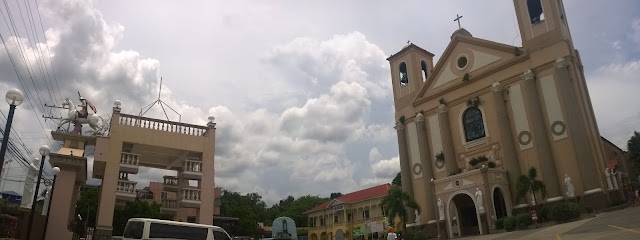I am typing this post today, July 25 on the feast day of St. James the Apostle also known as St. James the Greater. The patron saint of Spain, St. James is called Santiago and is at the centre of the ancient pilgrimage route known as the Camino de Santiago.
Last year, my friends and I walked the Camino, 134 kilometres from Triacastela to Santiago de Compostela. Since finishing the pilgrimage, I have come to think of St. James in more familiar terms -- in my mind, he's my Amigo Santiago.
While there are many images of Santiago along the Camino, this statue in the churchyard of Portomarin is my favourite. Clad in simple pilgrim's garb, he points the way for us peregrinos as
we continue on our Camino.
The Camino ends in Santiago de Compostela at the steps of the magnificent Baroque cathedral.
This photo is of the western or main entrance situated in the equally imposing square called the
Praza do Obradoiro.
The Cathedral built in the 12th century is undergoing renovations but even with the scaffolding hiding the major parts, it is still an awe inspiring sight. I still cannot find the words to describe how
I felt, as I rounded the corner and came upon the Cathedral, at the end of my Camino.
The Cathedral interiors are rich and grand yet exude a profound spiritual and almost mystical air.
At the centre altar is the famous statue of Santiago that for centuries, countless pilgrims have ardently and yes, even tearfully embraced to give thanks and praise at the end of
their Camino. Hanging in front of the statue is the giant incense burner, the Botafumeiro which
swings impressively overheard during special pilgrim masses.
Since the time we came back from the Camino, I have tried to see as many of the local churches dedicated to Amigo Santiago. Last year on a visit to Northern Luzon, I discovered that the town of Pasuquin, Ilocos Norte where I had regularly stopped many times before to load up on their unique "biscocho" , had a parish church dedicated to St. James.
Unlike many of the churches in Ilocos, the parish church of Pasuquin is quite new. The
town dates back to the 1700s but a much older church had previously succumbed to an earthquake.
It was unfortunate that I was not able to see if any of the ruins were left.

The statue of the pilgrim Santiago stands to the side of the main altar. I miss his pilgrim's hat but
he carries a staff and a small pouch.

Santiago was both pilgrim saint and moor slayer. It is said that he appeared in the battlefield and
held off the moors, thus keeping Spain staunchly Catholic. As warrior saint, he is shown astride
his horse, holding his sword.
On one of our frequent trips to Lucena, I noticed a familiar figure along the road. Sure enough, it was
Amigo Santiago, on top of his faithful steed in front of the St. James the Greater Parish Church
of Ibaan, Batangas.
Ibaan's towering church has been around since the 1870s. It was originally established by the Augustinians but is now under the Oblates of St. Joseph. From what I have read, it has also undergone renovations which have strayed from its original appearance.

The altar is beautiful and quite opulent, gilded in gold. Santiago as Apostle stands in the centre flanked by Our Lady and the Sacred Heart.
I go looking for Santiago the Moor Slayer and find him relegated to a side chapel in his classic warrior pose.
I left the best for last ....
This is a church that Jay and I have been regularly visiting long before I did the Camino. Ever since we first came here in the 1990s, we have tried to visit every year -- it is our own little pilgrimage of sorts. This is the St. James the Apostle Parish Church in Iguig, Cagayan Valley a few kilometres away from Tuguegarao. Can you just make out Santiago's statue on top of the church portico?
I wonder if he doesn't feel just a bit confined inside his glass case.
A marker on the red brick facade attests that the church was built in the 1600s.
White paint covers the thick and heavy walls inside the church. The main altar is quite simple and has a statue of St. James garbed in pilgrim attire. I wish I had a closer shot so that you could see the scallop shells decorating his cape. The scallop shell is the symbol of the Camino de Santiago.
And surprise, surprise -- Santiago as Moor Slayer is not hidden in a side chapel but stands prominently on the side, flanking the main altar.
You will only appreciate the grandeur and majesty of the church when you go around the
side and see the entire monumental structure, framed by nothing but the wide expanse of sky.
I enjoy taking friends here and bringing them around to see their gasps of surprise, awe and delight.
The massive buttresses at the back have helped hold up this church for centuries.
It is a splendid example of early Spanish church architecture in the Philippines -- in my mind it is one of the best.
I am sure Amigo Santiago is enjoying his spectacular church in this windswept perch on top of the hills of Iguig.
I shall continue to look for him in other corners of this country!














No comments:
Post a Comment